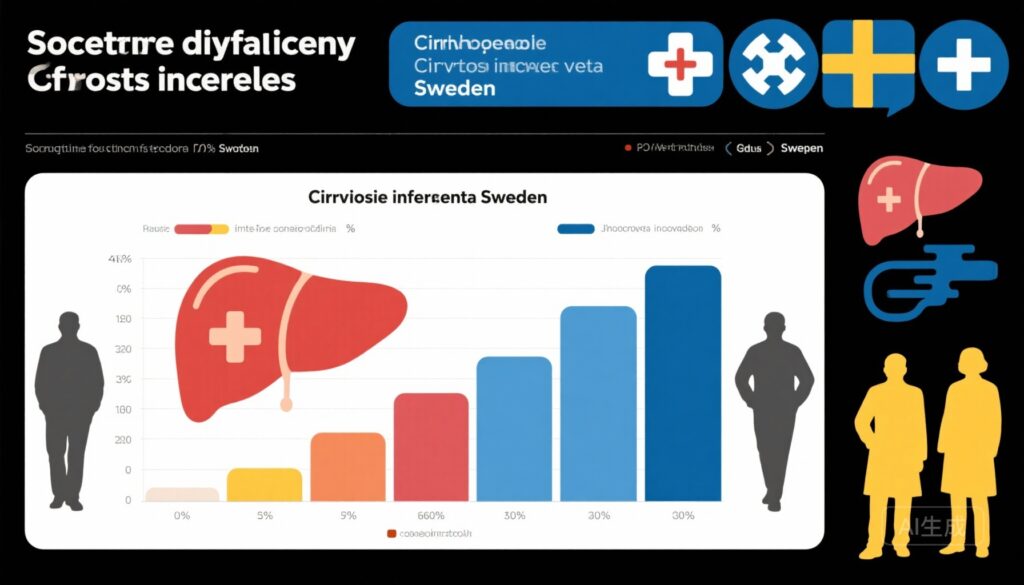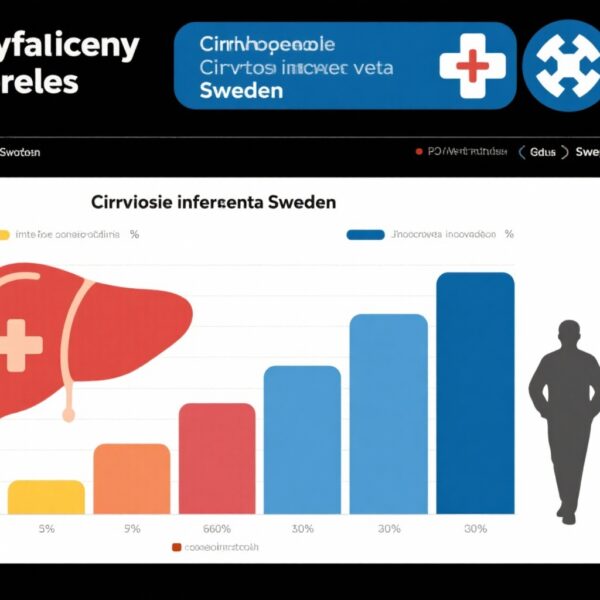Highlights
- Swedish nationwide registry data reveal a 30% increase in cirrhosis incidence from 2001 to 2022, predominantly driven by alcohol-related liver disease (ALD) and metabolic dysfunction-associated steatotic liver disease (MASLD).
- Marked socioeconomic disparities exist, with individuals in the lowest income quartile having a threefold higher risk of cirrhosis compared to those in the highest income quartile.
- Cirrhosis severity at diagnosis (based on major adverse liver outcomes) is comparable across income groups, indicating disparities reflect incidence rather than later-stage detection differences.
- Similar socioeconomic gradients and rising MASLD-related cirrhosis burdens are observed globally, underscoring the need for targeted prevention strategies focused on disadvantaged populations.
Background
Liver cirrhosis remains a leading cause of global morbidity and mortality. Its rising incidence is driven chiefly by two predominant etiologies: alcohol-related liver disease (ALD) and metabolic dysfunction-associated steatotic liver disease (MASLD). Socioeconomic disparities markedly influence the burden of these diseases, exacerbating health inequities. Sweden, a high-income country with comprehensive health registries, provides a unique platform to examine these dynamics longitudinally and by socioeconomic and demographic strata.
Key Content
Register-Based Evidence from Sweden (Vaz et al., 2025)
A comprehensive nationwide cohort study (2001-2022) by Vaz et al. analyzed 49,550 incident cirrhosis cases among individuals aged ≥15 years. Age-standardized incidence rates (ASIRs) increased by approximately 30% over two decades (from 22.4 to 29.1 per 100,000 persons). Notably, those in the lowest income quartile had over threefold higher incidence (incidence rate ratio [IRR] 3.11; 95% CI 3.03-3.20) relative to the highest income group. Importantly, analysis of major adverse liver outcomes (MALOs)—such as ascites, variceal bleeding, hepatic encephalopathy—showed comparable rates across income groups, suggesting equivalent disease severity at diagnosis and pointing towards differential disease development or exposure rather than capture bias in disadvantaged populations.
Temporal trends indicated increases in both ALD- and MASLD-related cirrhosis across all income categories, with the steepest rise in the lowest income group. Viral hepatitis-related cirrhosis initially increased in the low-income group until 2016, subsequently declining sharply, reflecting successes in viral hepatitis management.
Global and Regional Epidemiological Trends
Supporting the Swedish data, a global burden of disease analysis (2025) demonstrated the rising incidence of MASLD-related cirrhosis worldwide, accelerated by aging populations and increased metabolic risk factors, including obesity and type 2 diabetes. Low-to-middle socioeconomic index countries endure the greatest burden with limited healthcare resources. Similarly, studies from England noted a tripling of alcohol-related liver disease incidence among the most deprived quintile (2001-2018), closely paralleling the Swedish findings and reinforcing the role of socioeconomic factors in cirrhosis risk.
Socioeconomic and Behavioral Drivers of Liver Disease
Socioeconomic position (SEP) intertwines with behavioral risk factors—smoking, alcohol misuse, obesity—and access to care. Swedish cohort analyses controlling for familial alcohol use disorder genetic liability confirmed persistent SEP disparities independent of genetic risk, implicating environmental and social determinants as key disease drivers.
In people living with HIV and hepatitis B, behavioral factors such as tobacco use and elevated BMI heighten liver disease progression risk, emphasizing the complex interplay between biological and social determinants.
Clinical Implications and Disease Management Reflections
Cirrhosis is often diagnosed at advanced stages with frequent readmissions and high mortality, as demonstrated by studies evaluating predictors of early hospital readmission (e.g., low hemoglobin and high MELD-Na scores). Despite comparable severity at diagnosis across socioeconomic groups in Sweden, disadvantaged patients may face barriers to ongoing care and preventative interventions.
The rising prevalence of MASLD in younger working-age populations globally underscores the urgency for early risk stratification and intervention, targeting modifiable factors such as obesity, diabetes, and alcohol consumption, particularly in low SEP groups.
Expert Commentary
The Swedish register-based study exemplifies the modern epidemiological approach to dissect cirrhosis trends by integrating comprehensive demographic, socioeconomic, and clinical data. Its robust methodology—population-wide inclusion, validated case ascertainment, and temporal analysis—provides high external validity for similar high-income settings.
The socioeconomic gradient in cirrhosis incidence persisting despite equal disease severity at diagnosis highlights primary prevention failings in vulnerable groups rather than disparities in healthcare access or referral. This finding directs clinical and public health focus towards upstream determinants: alcohol use behaviors, metabolic syndrome management, and social environment enhancement.
Mechanistically, socioeconomic deprivation may amplify exposure to alcohol and unhealthy diets, increase psychosocial stress, and limit access to health-promoting resources. Integrating social determinants into hepatology practice and public health policies is critical to close the health equity gap.
Furthermore, the global rise of MASLD-related cirrhosis, particularly in low- and middle-income contexts, demands scalable, culturally-tailored preventive approaches. The Swedish data reinforce the universal nature of these trends, suggesting lessons applicable beyond national borders.
Limitations include the inability to account for individual-level alcohol consumption and lifestyle factors in registry data and potential residual confounding. Future research should incorporate qualitative assessments and intervention trials targeting disadvantaged groups.
Conclusion
The incidence of liver cirrhosis in Sweden is rising, driven predominantly by ALD and MASLD, with a pronounced socioeconomic gradient placing low-income individuals at threefold higher risk. This disparity persists despite similar disease severity at diagnosis, underlining a critical need for targeted primary prevention and early detection strategies focused on vulnerable populations.
Globally, the increasing burden and socioeconomic disparities in cirrhosis demand integrated public health and clinical interventions addressing social determinants, behavioral modification, and metabolic health.
Future research directions should prioritize longitudinal evaluation of socioeconomic factors, interventions reducing alcohol and metabolic risk exposures, and health systems strengthening to ensure equitable access to cirrhosis management.
References
- Vaz J, Lazarus JV, Strömberg U, Hagström H. Cirrhosis incidence across socioeconomic and demographic groups in Sweden: a register-based cohort study. Lancet Public Health. 2025 Nov;10(11):e933-e942. doi: 10.1016/S2468-2667(25)00228-2. PMID: 41162128.
- Wang H, et al. Time trends and health inequalities of cirrhosis caused by metabolic dysfunction-associated steatotic liver disease from 1990 to 2021: a global burden of disease study. J Endocrinol Invest. 2025 Nov;48(11):2599-2614. doi: 10.1007/s40618-025-02631-3. PMID: 40553425.
- Grander J, et al. Socioeconomic position indicators and risk of alcohol-related medical conditions: A national cohort study from Sweden. PLoS Med. 2024 Mar 19;21(3):e1004359. doi: 10.1371/journal.pmed.1004359. PMID: 38502640.
- O’Sullivan ED, et al. Low haemoglobin level predicts early hospital readmission in patients with cirrhosis and acute decompensation. JHEP Rep. 2023 Feb 11;5(5):100698. doi: 10.1016/j.jhepr.2023.100698. PMID: 37025944.
- Jepsen P, et al. Population-Based Study of Alcohol-Related Liver Disease in England in 2001-2018: Influence of Socioeconomic Position. Am J Gastroenterol. 2024 Jul;119(7):1337-1345. doi: 10.14309/ajg.0000000000002677. PMID: 38299583.



